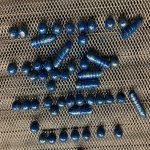- Location
- Western Manitoba
Pardon the dumb question, but has anyone powder coated copper jacketed bullets. I have the feeling I'm going to get a barrage of "why would you do that????". Just curious, that's all.
I would think could try to get .308" jacketed bullets up to .310" for 7.62x39, or perhaps to .311" / .312" for 303 British or 7.65 Argentine? if you try to do so, let us know how that worked - might "tip me over" the edge, to try it ... Might even work to create .228" bullets from .224"? For extreme, I have a 0.282" groove barrel, perfectly chambered for 270 Win - so typical .277" bullets are like .005" too small ...










































































